Geology > AS Mark Scheme > GCE Geology H414/03: Practical skills in geology Advanced GCE Mark Scheme for Autumn 2021 (All)
GCE Geology H414/03: Practical skills in geology Advanced GCE Mark Scheme for Autumn 2021
Document Content and Description Below
Oxford Cambridge and RSA Examinations GCE Geology H414/03: Practical skills in geology Advanced GCE Mark Scheme for Autumn 2021Oxford Cambridge and RSA Examinations OCR (Oxford Cambridge and RSA... ) is a leading UK awarding body, providing a wide range of qualifications to meet the needs of candidates of all ages and abilities. OCR qualifications include AS/A Levels, Diplomas, GCSEs, Cambridge Nationals, Cambridge Technicals, Functional Skills, Key Skills, Entry Level qualifications, NVQs and vocational qualifications in areas such as IT, business, languages, teaching/training, administration and secretarial skills. It is also responsible for developing new specifications to meet national requirements and the needs of students and teachers. OCR is a not-for-profit organisation; any surplus made is invested back into the establishment to help towards the development of qualifications and support, which keep pace with the changing needs of today’s society. This mark scheme is published as an aid to teachers and students, to indicate the requirements of the examination. It shows the basis on which marks were awarded by examiners. It does not indicate the details of the discussions which took place at an examiners’ meeting before marking commenced. All examiners are instructed that alternative correct answers and unexpected approaches in candidates’ scripts must be given marks that fairly reflect the relevant knowledge and skills demonstrated. Mark schemes should be read in conjunction with the published question papers and the report on the examination. © OCR 2021H414/03 Mark Scheme November 2021 Annotations Annotation Meaning Correct response Incorrect response Omission mark Benefit of doubt given Contradiction Rounding error Error in number of significant figures Error carried forward Level 1 Level 2 Level 3 Benefit of doubt not given Noted but no credit given Ignore Blank pageH414/03 Mark Scheme November 2021 Abbreviations, annotations and conventions used in the detailed Mark Scheme (to include abbreviations and subject-specific conventions). Annotation Meaning DO NOT ALLOW Answers which are not worthy of credit IGNORE Statements which are irrelevant ALLOW Answers that can be accepted ( ) Words which are not essential to gain credit __ Underlined words must be present in answer to score a mark ECF Error carried forward AW Alternative wording ORA Or reverse argumentH414/03 Mark Scheme November 2021 4 Question Answer Mark AO element Guidance 1 (a) i 55-60(cm) 1 AO2.1b +/- 5cm as there is a slight variation in throw between different beds 1 (a) ii 45(°) 1 AO2.1b +/- 5o 1 (a) iii 25(%) Overall length of crust before faulting = 200cm Overall length of crust after faulting = 250cm 250 200 =1.25 Therefore extension is 25% OR 50cm +/- 5 cm 2 AO2.1b ACCEPT answers given in cm ACCEPT Measurement to show the extension of rocks along the fault is in the region of 1.5cm as measured on the photo for 1 mark 1 (b) i Appropriate diagram showing a fault trap AND Any three correct labels: Cap rock Reservoir rock Fault plane Oil and/or Gas 4 AO1.1c DO NOT ALLOW Impermeable rock instead of Cap rock OR Permeable rock instead of Reservoir rockH414/03 Mark Scheme November 2021 Question Answer Mark AO element Guidance 1 (b) ii Description of how Oil and Gas can be destroyed if the temperature increases above 200oC OR Loss of Oil and Gas by erosion and removal of overlying caprock OR Loss of Oil and Gas by migration along an unsealed fault plane / fault movement can increase permeability along fault plane 1 AO1.1a DO NOT ALLOW Migration up fault without reason 1 (b) iii Any two oil traps from: Lithological trap Anticline trap Unconformity trap Salt Dome trap 1 AO1.1a DO NOT ALLOW Fault trap ALLOW Antiform trap 1 (c) i Labels correct on both axes AND Units correct on x and y-axis AND sensible scales used ALL points plotted correctly AND line of best fit included 2 AO2.1 ALLOW 1 mark max if axes are reversed. ALLOW 1 plotting error if line of best fit is included ALLOW if 6 accurate points are plotted but no Line of Best Fit DO NOT ALLOW no line of best fit with only 5 points correctly plottedH414/03 Mark Scheme November 2021 Question Answer Mark AO element Guidance 1 (c) ii Elastic deformation labelled correctly in the zone below 2Kg and 10cm Elastic limit labelled correctly at 2Kg and 10cm 2 AO2.1b DO NOT ALLOW Elastic deformation to be labelled with one arrow to a single point it MUST be shown as a range, for all or part of the line, using brackets or arrows 1 (c) iii A line drawn below the initial plotted line, clearly labelled T 1 AO3.1f If the axes are drawn the wrong way round the line T should plot above the line of points already plottedH414/03 Mark Scheme November 2021 Question Answer Mark AO element Guidance 1 (c) iv The measurement of extension in cm for each mass was accurate to ± 0.05cm OR Uncertainty is an estimate attached to a measurement which characterises the range of values within which the true value lies 1 AO2.1a ALLOW examples e.g. for 0.5kg Mass, the extension is a figure between 2.45cm and 2.55cm. 1 (c) v Stress is the term used to describe the forces applied to a rock (by Earth movements or the weight of overlying rocks) OR Stress is the force (per unit area) acting upon a rock 1 AO2.1b ALLOW reference to an external force acting upon a rockH414/03 Mark Scheme November 2021 Question Answer Mark AO element Guidance 2 (a) Boundaries between rock types Suitable key with correct symbols for rock types Any two from: Correctly drawn fault along the stream Dyke marked in the North part of the map orientated East-West Clear indication of the fold structure (synform / syncline) with dip arrows or labels Metamorphic marble drawn next to dyke Plane of unconformity / unconformable Sandstone 4 AO2.1b AO3.1a ALLOW some difference in the positions of the boundaries from the drawn map providing outcropping areas are correctly drawn OR a correct more complex solution. ALLOW one plotting error of rock type on key ALLOW different widths / lengths of dyke providing the orientation is roughly eastwestH414/03 Mark Scheme November 2021 Question Answer Mark AO element Guidance 2 (b) Any three from: Erosion / Weathering Transportation Deposition / sedimentation Compaction / lithification / cementation / diagenesis 1 AO2.1aH414/03 Mark Scheme November 2021 Question Answer Mark AO element Guidance 2 (c) Please refer to the marking instructions on page 4 of this mark scheme for guidance on how to mark this question. Level 3 (5–6 marks) Gives a detailed outline of the steps required to produce an accurate graphic log, linking rock types to detailed application of knowledge and understanding of Deltaic environments, their associated sediments and deltaic structure, as well as geological fieldwork techniques, including the need for safe working practices. There is a well-developed line of reasoning which is clear and logically structured. The information presented is relevant and substantiated. Level 2 (3–4 marks) Gives an outline of some of the steps required to produce a graphic log, linking to the demonstration of some knowledge of Deltaic environments and their associated sediments and structure as well as geological fieldwork techniques including some reference to safe working practices. There is a line of reasoning presented with some structure. The information presented is relevant and supported by some evidence. Level 1 (1–2 marks) Gives a basic outline of some of the steps required to produce a graphic log, there are links to demonstrate some knowledge of Deltaic environments and geological fieldwork techniques, but these are relatively basic. Only one of the two sections may be covered (either fieldwork technique or knowledge of deltaic environments) There is an attempt at a logical structure with a line of reasoning. The information is in the most part relevant. 6 AO1 AO2 AO3 AO1.1 - Demonstrate knowledge and understanding of geological skills and techniques • discusses safe working practices in the field especially if in a coastal location • reports on trends in orientation • fossils mentioned but not identified • reference to beds and bedding planes • Describes how to use a compass clinometer to take dip and strike readings. • Describes how to use a compass clinometer to take dip and dip direction readings. • Describes how to measure flow directions using sedimentary structures or linear data commonly found in a deltaic environment. • Able to link rock types and sedimentary structures to deltaic sequences. E.g. Delta top channel sandstones with asymmetrical ripples, seat earths and coal. Delta front sandstones with marine fossils and symmetrical ripples, siltstones. Pro delta limestone or shale AO2.1b - Apply knowledge and understanding of geological skills and techniques • bed thickness measured accurately and consistently using appropriate equipment. • uses standard symbols • sketches sedimentary structures • Links the Rock types and structures seen to the associated parts within a deltaic sequence.H414/03 Mark Scheme November 2021 Question Answer Mark AO element Guidance 0 marks No response or no response worthy of credit. • Recognises repeated beds such a deltaic cyclothem sequence. • 3 S’s: grain size; shape; sorting • 3 C’s: colour; composition and cement AO3.1a, b and c – Analyse, Interpret and Evaluate geological ideas, information and evidence • Able to link rock types and sedimentary structures to deltaic sequences. E.g. Delta top channel sandstones with asymmetrical ripples, seat earths and coal. Delta front sandstones with marine fossils and symmetrical ripples, siltstones. Pro delta limestone or shale AO3.1d – Make judgements • Able to make the judgement that the rock types are linked to a deltaic sequence. AO3.1e – Draw conclusions • Able to conclude that the sequence described is of Deltaic origin.H414/03 Mark Scheme November 2021 Question Answer Mark AO element Guidance 3 (a) i Asymmetrical ripples 1 AO3.1b DO NOT ALLOW ripples 3 (a) ii Flute casts are deepest AND widest at their proximal end/closest to their source/ get narrower AND shallower with distance from their source/distal end Flute casts are erosional features scoured / eroded by a turbidity current / eddy current as it flows across the seabed / fine grained sediment from previous flows OR As the turbidity current loses energy coarse sediment / sand sized sediment is deposited in the eroded cast which helps to preserve it 2 AO1.1b ALLOW answer as an annotated diagram 3 (b) i Orientation (Degrees) Number of observations Orientation (Degrees) Number of observations 1-30 2 181-210 2 31-60 2 211-240 0 61-90 0 241-270 2 91-120 1 271-300 2 121-150 3 301-330 0 151-180 5 331-360 1 2 AO2.1b ALLOW as a tally chart instead of numbers ALLOW 1 mark if there is one error 3 (b) ii Suitable scale clearly marked along one of the spokes of the rose diagram Data plotted correctly 2 AO3.1a DO NOT ALLOW Diagram plotted equally on both sides. ALLOW ECFH414/03 Mark Scheme November 2021 Question Answer Mark AO element Guidance 3 (b) iii Main direction SSE/SE 1 AO3.1b ALLOW answers given as a compass direction e.g. SSE Between 151 – 180 (degrees) 3 (b) iv Between 151 – 180 degrees 1 AO2.1b 3 (c) Level 3 (5–6 marks) Gives a detailed description of a practical design and procedures which demonstrates good knowledge and understanding of geological ideas. There is a well-developed line of reasoning which is clear and logically structured. The information presented is relevant and substantiated. Level 2 (3–4 marks) Gives a description of a practical including some of the necessary procedures. Some knowledge of geological ideas is demonstrated. There is a line of reasoning presented with some structure. The information presented is relevant and supported by some evidence. Level 1 (1–2 marks) Gives a simple description of a practical including a simple procedure which demonstrates a basic knowledge of geological ideas. 6 AO1 AO3 AO1.1a - Demonstrate knowledge of geological ideas • Links flow direction to formation of Turbidity currents • States preserved sedimentary structures formed by same processes. AO1.1c - Demonstrate understanding of geological ideas • Links Turbidites with formation of graded bedding • references sedimentary structures and way up criteria AO3.1f - Develop and refine practical design and procedures • recognises need for repetitionH414/03 Mark Scheme November 2021 Question Answer Mark AO element Guidance There is an attempt at a logical structure with a line of reasoning. The information is in the most part relevant. 0 marks No response or no response worthy of credit. • discusses safe working practices • discusses experimental procedure • simple experiment only • example of simple equipment using aquarium, sloped tube / pipe clean washed sand and water • method described • recognises error • recording of data discussed. • Needs reference to introduction of a sediment laden flow, maybe from another container to be poured into the main flume/pipeH414/03 Mark Scheme November 2021 Question Answer Mark AO element Guidance 4 (a) A labelled fault in the correct position dissecting the shale and limestone in 0699 - 0798 A labelled fault at the correct position in the sandstone and marl in 0697 The surface geological boundary between the Old Red Sandstone and younger sediments offset at the fault 3 AO3.1a AO3.1b ALLOW rock types as labels or drawn as a key with appropriate symbols ALLOW plotting tolerance of 0.2 Km (5mm) using map scale ALLOW fault in 0698 – 0699 to be labelled as dissecting the shale and limestone if it is not labelled for affecting the sandstone and marlH414/03 Mark Scheme November 2021 Question Answer Mark AO element Guidance 4 (b) Beds on the NE limb dip SW at 63 - 65 degrees Beds on the SW limb shown on the map to dip NE 95 once plotted should be just beyond vertical 3 or more beds on the cross section clearly labelled using the codes from the map insert or suitable symbols 3 AO2.1b AO3.1c ALLOW a tolerance of ± 5 degrees in the dip of the strata on either side of the fold structure. ALLOW a dip of 85-90 degrees as overturned beds may cause some confusionH414/03 Mark Scheme November 2021 Question Answer Mark AO element Guidance 4 (c) Any one Geophysical technique AND explanation from: Gravity survey (using a Gravimeter) to measure small variations in the Earths gravitational field strength AND A positive anomaly could be due to the presence of dense, metallic ore minerals (e.g. Haematite or Magnetite) Magnetic survey (using a magnetometer) to measure small variations in the Earth’s magnetic field strength AND A positive anomaly could be due to a mafic / ultramafic intrusion containing cumulate ore deposits OR the presence of the mineral Magnetite Electromagnetic (EM) Surveys measuring ground conductivity (by the process of electromagnetic induction) AND Positive EM anomaly could indicate conductive materials such as metallic mineral ores Electrical resistivity survey measuring the resistivity of the ground (by passing an electric current between two electrodes) AND A lower resistivity could indicate metallic mineral ores in the ground 2 AO1.1c AO1.1d 4 (d) Lydstep point is predominantly composed of Limestone AND Limestone could be chemically weathered to form caverns / voids leading to surface subsidence mitigation technique such as using reinforced raft foundations / isolating foundations of buildings from the movement of the surface with layers of PVC / sand 2 AO1.1d AO2.1b 1 mark for identification of the cause of subsidence AND 1 mark for the mitigation methodH414/03 Mark Scheme November 2021 Fault and Gash Breccia present at part of the headland AND could act as line of weakness and cause subsidence / the fault could be re-activated and the weak gash breccia could collapse causing subsidence mitigation technique could be to grout the fault to seal and strengthen it / add rock bolts across the weakened rocks of the fault zone to help stabilise them 5 (a) A: Mafic B: Silicic C: Intermediate D: Ultramafic 2 AO3.1e ALLOW older terminology, if correctly used 2-3 correct = 1 mark 1 correct = 0 mark 5 (b) Any 4 from: Coarse crystals / crystals over 5mm in size AND Slow cooling / time/plutonic cooling allowed large crystals to form OR Insulation effect of rock surrounding a deep intrusion keeps the Nucleation rate low, resulting in fewer crystals but larger sized crystals Composed of different minerals from both parts /sides of Bowens Reaction Series / 3 named minerals from Olivine, Augite / Pyroxene or Biotite Mica, (from the Discontinuous reaction series) or Ca rich plagioclase (from the Continuous Reaction Series) Some minerals crystallised in order of the discontinuous part of Bowens reaction series with Olivine first then Augite/Pyroxene OR Olivine forms first but reacts with the surrounding magma and changes slowly to Augite/Pyroxene/ reaction of early formed Olivine which is out of phase with the magma to form augite/pyroxene/ reaction rims form 4 AO1.1a AO2.1b ALLOW most crystals are over 5mm in size DO NOT ALLOW the use of the term grains instead of crystals ACCEPT reverse argument discussing cooling rates for small crystals as long as reference is made to some crystals being largerH414/03 Mark Scheme November 2021 Ca rich Plagioclase feldspar forms (from the continuous reaction series) shortly after olivine begins to form/ at a similar time to olivine / does not react with the magma/ continually changes composition as the magma changes/ forms zoned crystals 5 (b) ii Any 1 from: interlocking crystals increases the strength of igneous rocks as there are no spaces in between crystals they cannot be compressed / produce a strong rock there are few planes of weakness as all crystal faces are in contact with the neighbouring crystal 1 AO2.1aOCR (Oxford Cambridge and RSA Examinations) The Triangle Building Shaftesbury Road Cambridge CB2 8EA [Show More]
Last updated: 1 year ago
Preview 1 out of 21 pages

Reviews( 0 )
Document information
Connected school, study & course
About the document
Uploaded On
Oct 10, 2022
Number of pages
21
Written in
Additional information
This document has been written for:
Uploaded
Oct 10, 2022
Downloads
0
Views
51








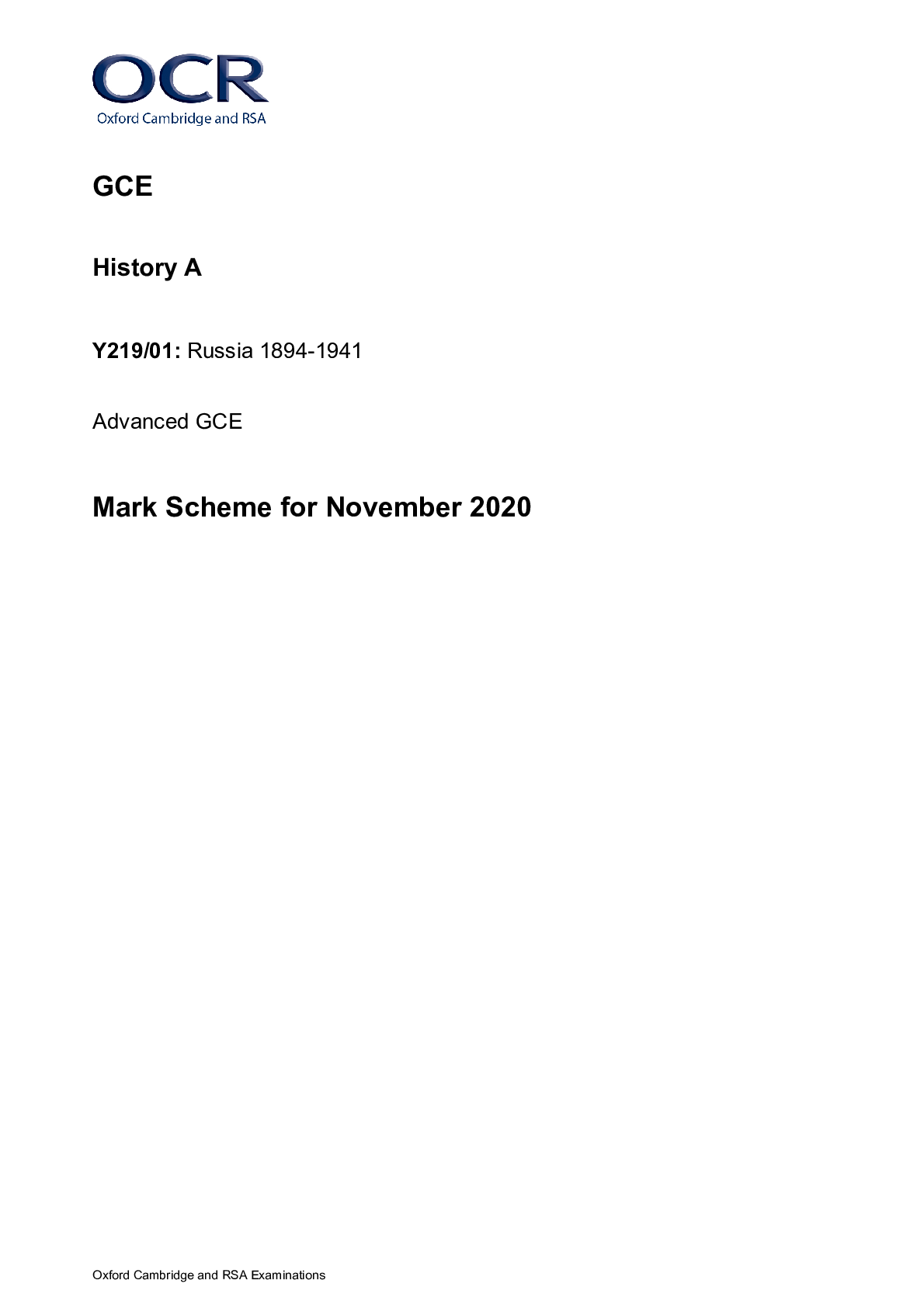
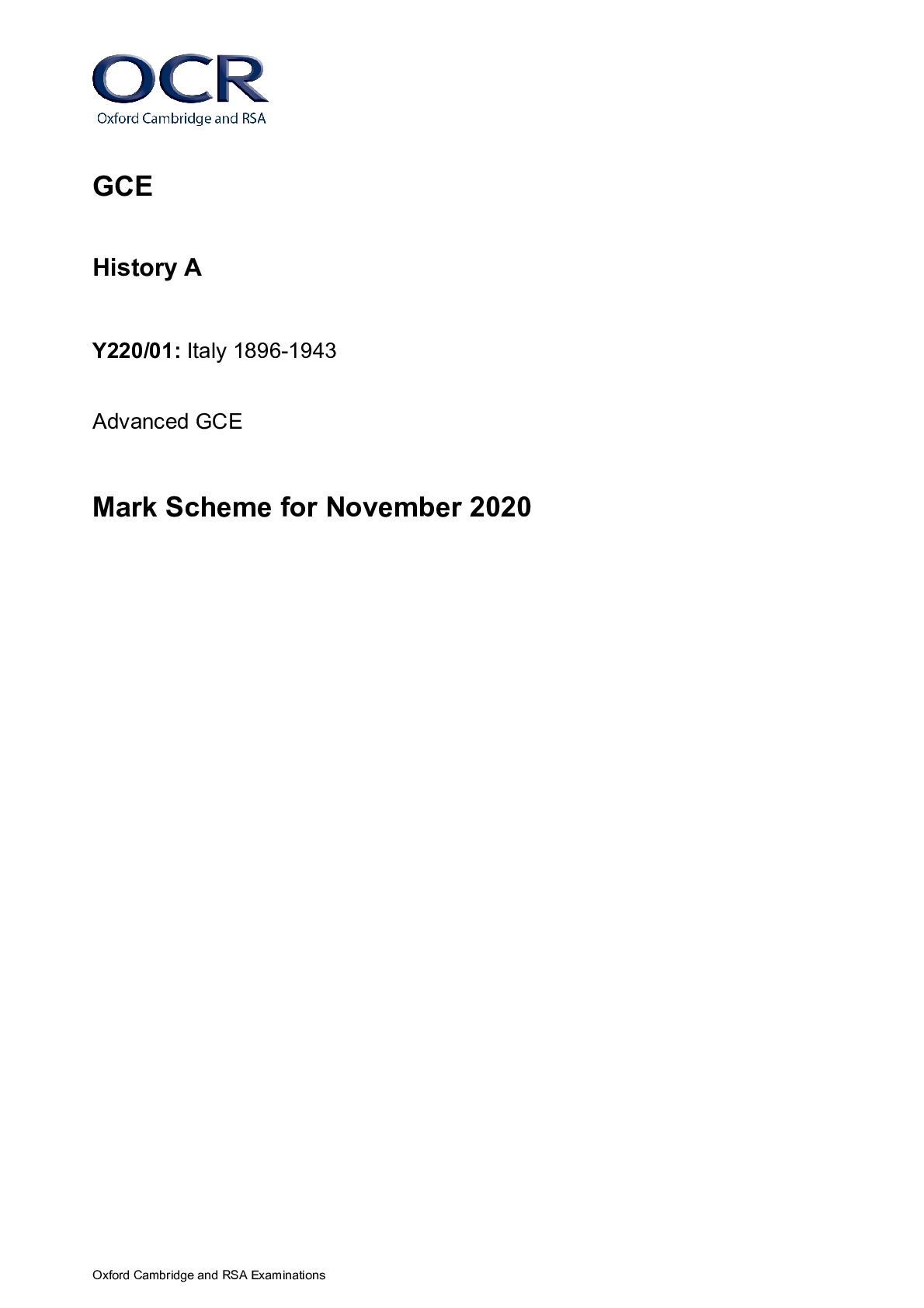

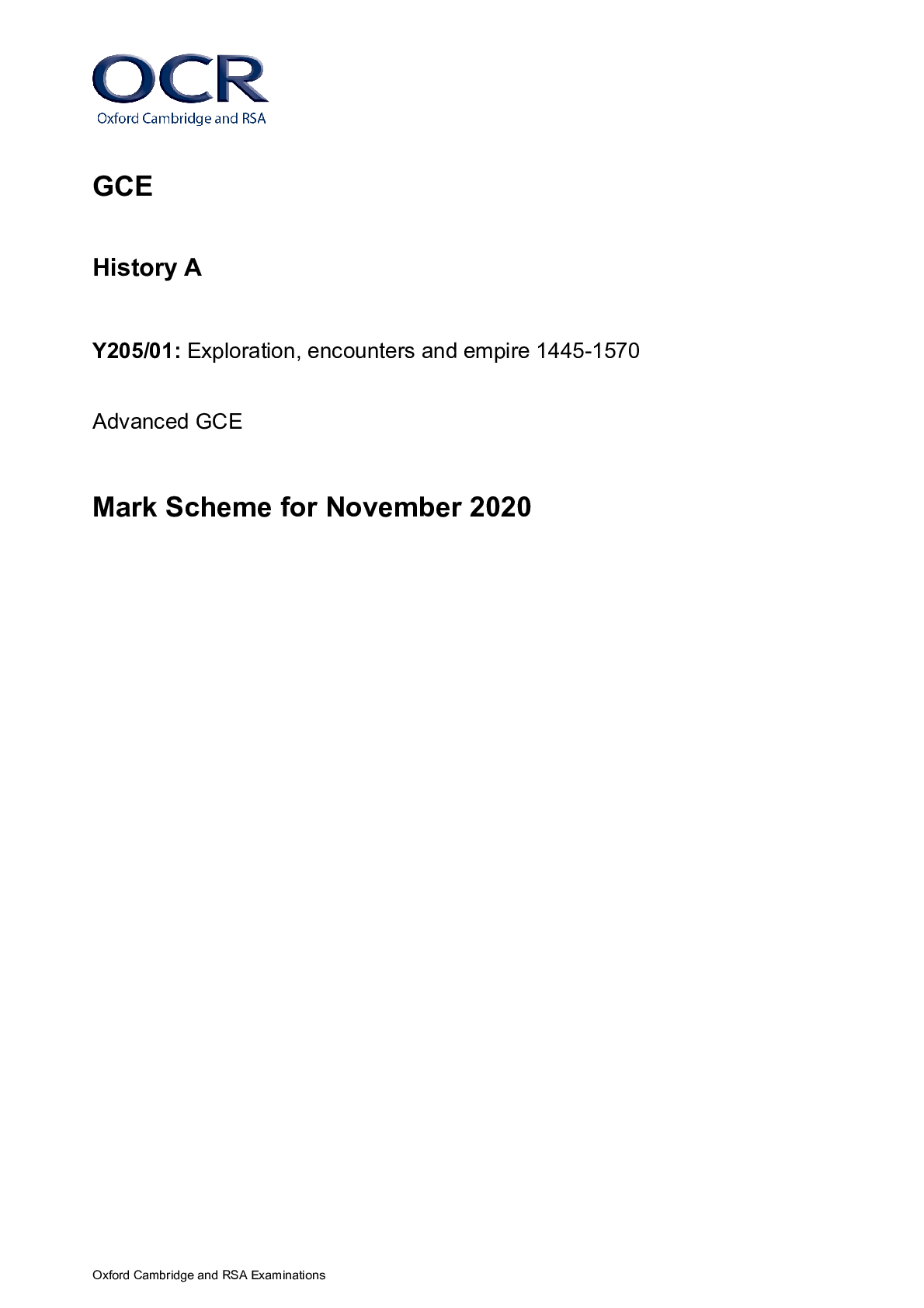
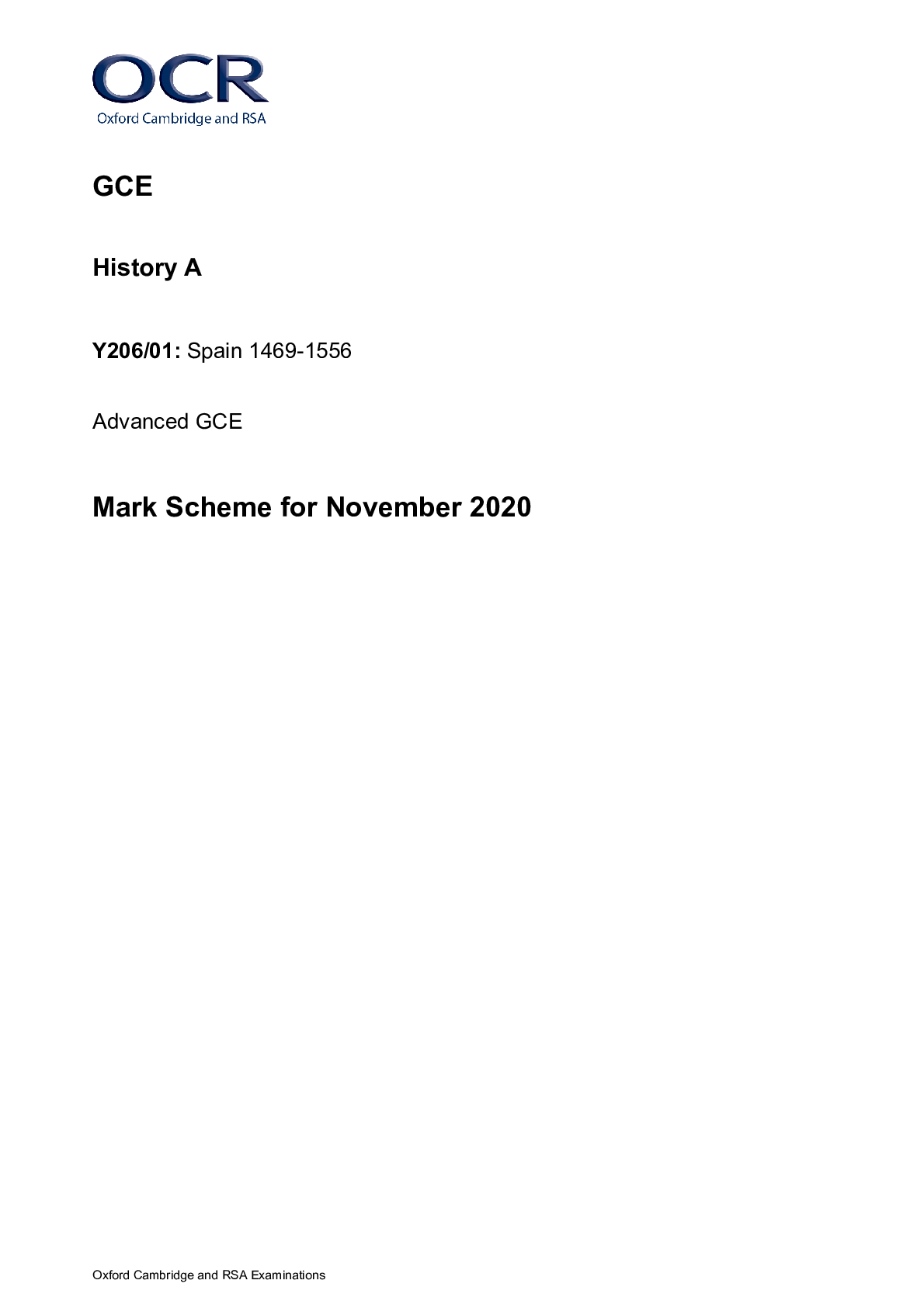
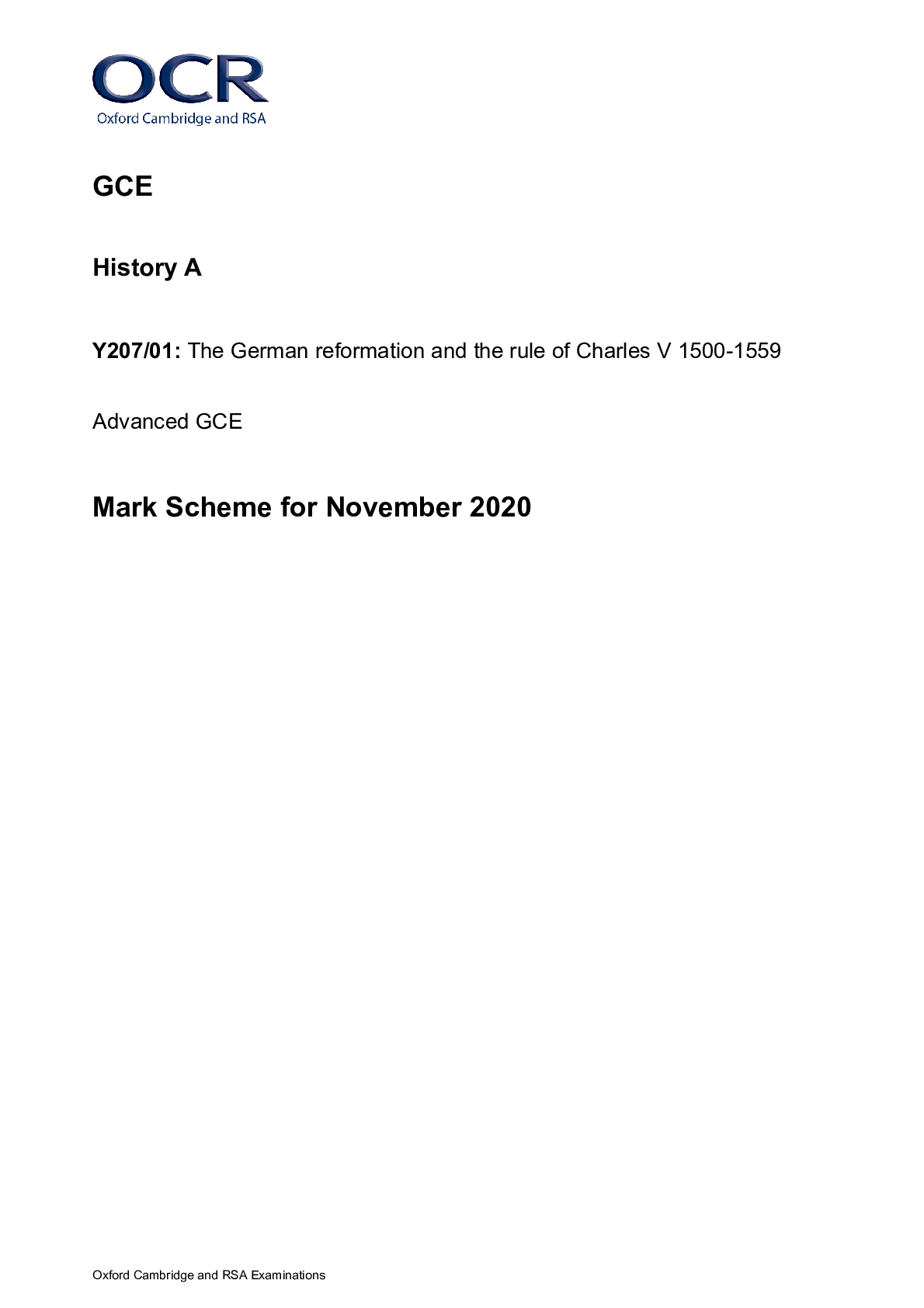
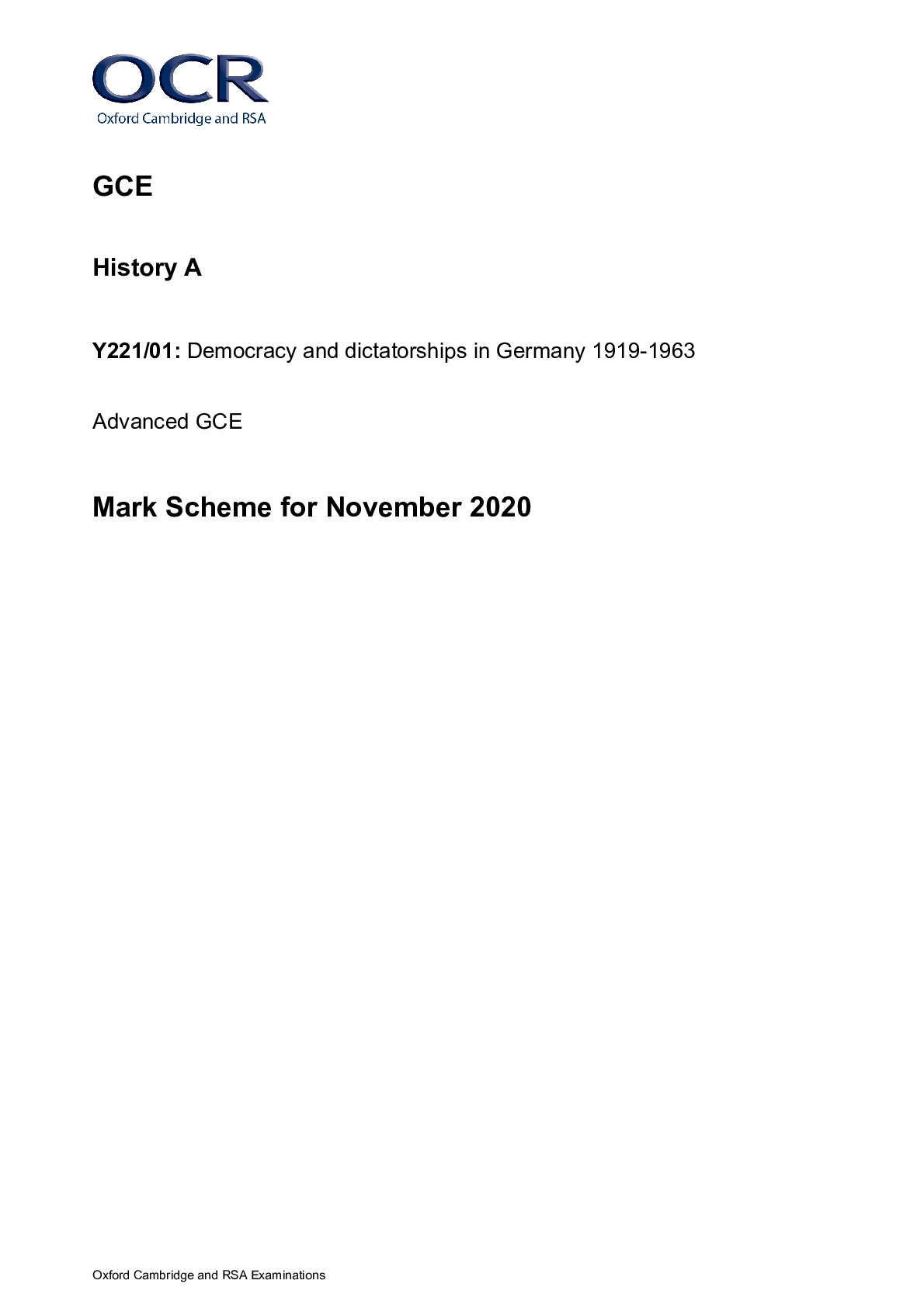

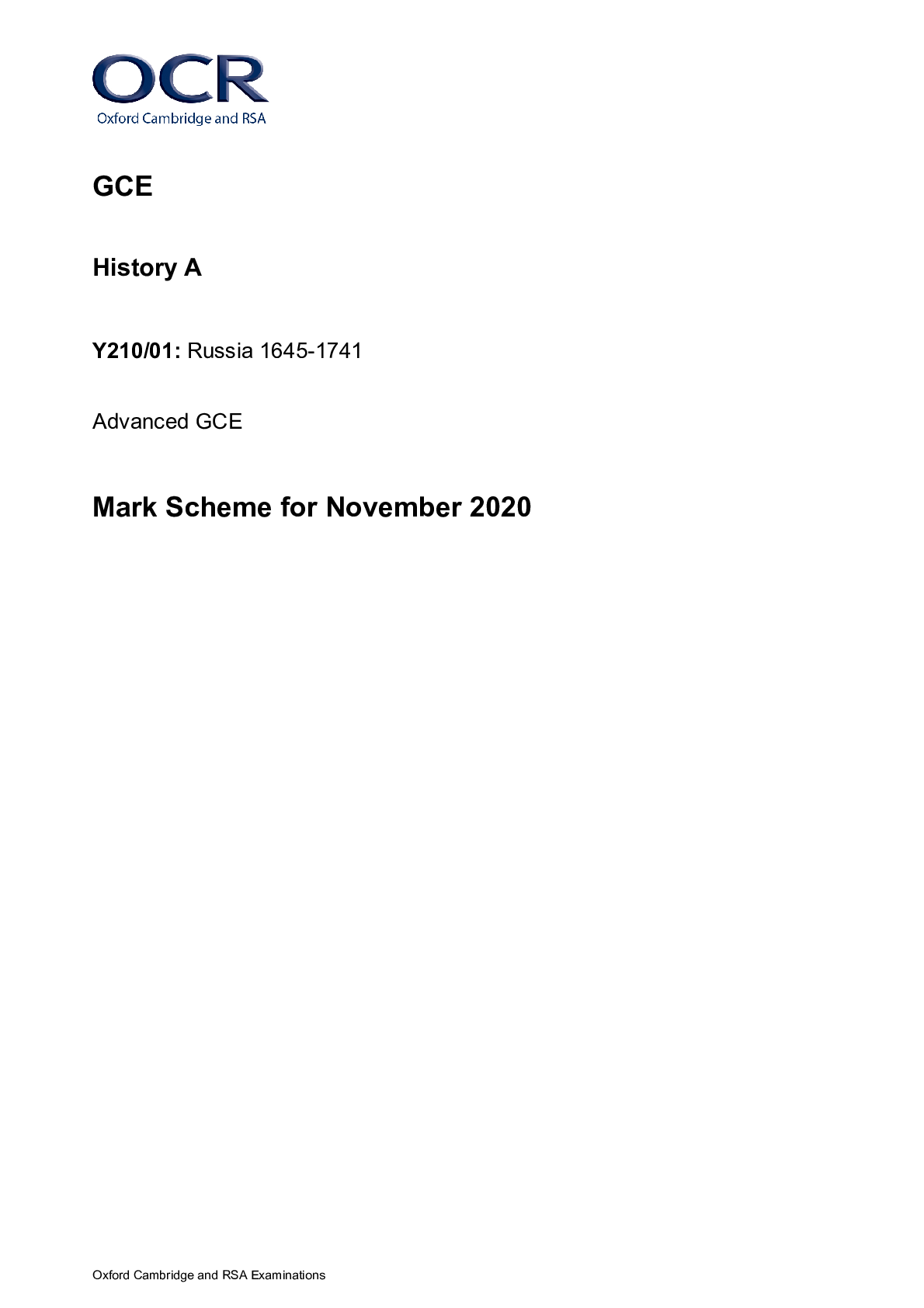


.png)






